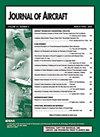基于开关阀的飞机制动系统抗扰滑移率算法
IF 2.1
3区 工程技术
Q2 ENGINEERING, AEROSPACE
引用次数: 0
摘要
安全高效的制动过程是飞机制动系统的首要考虑因素。传统的伺服阀容易堵塞,造成严重的安全事故。在分析制动系统工作原理的基础上,提出了一种基于开关阀的更安全的飞机制动系统,该系统采用常开阀作为下游阀。基于开关阀的制动系统存在压力波动大、工作条件恶劣、系统非线性强等问题。针对上述问题,提出了一种抗干扰能力强、制动效率高的算法。该算法通常由两个主要部分组成:外部循环和内部循环。外环采用自抗扰控制,内环采用带补偿的分段非线性预测压力调节算法。外环可以补偿系统的内部不确定性和外部干扰。内回路可以补偿开关阀关闭过程中的流量,以保证压力调节效果和开关阀的使用寿命。实验结果表明,该算法具有较强的抗干扰能力和较高的调节精度。在三种不同工况下,该算法的制动距离可缩短5.48 ~ 15.15%,显著提高了飞机的制动效率。本文章由计算机程序翻译,如有差异,请以英文原文为准。
Antidisturbance Slip Ratio Algorithm of Aircraft Braking System Based on On/Off Valves
A safe and high-efficiency braking process is the primary consideration for the aircraft braking system. The traditional servo valve is prone to blockage, which can cause serious safety accidents. Based on the analysis of the operation principle of the braking system, a safer aircraft braking system based on an on/off valve is proposed, which uses a normally open valve as the downstream valve. The braking system based on on/off valves has problems such as fluctuating pressure, harsh working conditions, and strong nonlinearity of the system. An algorithm with a strong antidisturbance ability and high braking efficiency is proposed to solve the above three problems. The algorithm typically consists of two main components: outer and inner loops. The outer loop uses the active disturbance rejection control, and the inner loop adopts the segmented nonlinear predictive pressure regulation algorithm with compensation. The outer loop can compensate for the internal uncertainty and external disturbance of the system. The inner loop can compensate for the flow rate during the closing process of the on/off valve to ensure the pressure regulation effect and the life of the on/off valve. The experimental results show that the proposed algorithm has a strong antidisturbance ability and high regulation precision. The braking distance of the algorithm can be reduced by 5.48–15.15% under three different working conditions, which significantly improves the braking efficiency of the aircraft.
求助全文
通过发布文献求助,成功后即可免费获取论文全文。
去求助
来源期刊

Journal of Aircraft
工程技术-工程:宇航
CiteScore
4.50
自引率
31.80%
发文量
141
审稿时长
6 months
期刊介绍:
This Journal is devoted to the advancement of the applied science and technology of airborne flight through the dissemination of original archival papers describing significant advances in aircraft, the operation of aircraft, and applications of aircraft technology to other fields. The Journal publishes qualified papers on aircraft systems, air transportation, air traffic management, and multidisciplinary design optimization of aircraft, flight mechanics, flight and ground testing, applied computational fluid dynamics, flight safety, weather and noise hazards, human factors, airport design, airline operations, application of computers to aircraft including artificial intelligence/expert systems, production methods, engineering economic analyses, affordability, reliability, maintainability, and logistics support, integration of propulsion and control systems into aircraft design and operations, aircraft aerodynamics (including unsteady aerodynamics), structural design/dynamics , aeroelasticity, and aeroacoustics. It publishes papers on general aviation, military and civilian aircraft, UAV, STOL and V/STOL, subsonic, supersonic, transonic, and hypersonic aircraft. Papers are sought which comprehensively survey results of recent technical work with emphasis on aircraft technology application.
 求助内容:
求助内容: 应助结果提醒方式:
应助结果提醒方式:


